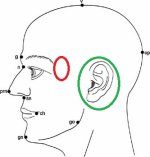sinman0531
Guru
Hey everyone,
I have a provider who performed a MOHs on a patient in early December and based on the photos of the site, it is very clearly the face (the site is on the temple), however, he marked it as "preauricular" on our internal MOHs documentation, in the chart, and on the pathology requisition. If I send the claim out with the diagnosis of C44.212, it's going to deny. However, the regional office manager says there is "nothing they can do" to change the wording because the path report lists the site as "preauricular". I know for a fact they can send a correction to the lab and fix it, and if I tell the doctor that his procedure that cost thousands of dollars was not paid because the record was worded incorrectly he will flip. Does anyone know where I could find an anatomical map of the "regions" of the face? Logic obviously isn't playing a part here, so I have to have hard proof of the difference in locations from a medical perspective (not just my opinion) before I suggest sending the correction.
I have a provider who performed a MOHs on a patient in early December and based on the photos of the site, it is very clearly the face (the site is on the temple), however, he marked it as "preauricular" on our internal MOHs documentation, in the chart, and on the pathology requisition. If I send the claim out with the diagnosis of C44.212, it's going to deny. However, the regional office manager says there is "nothing they can do" to change the wording because the path report lists the site as "preauricular". I know for a fact they can send a correction to the lab and fix it, and if I tell the doctor that his procedure that cost thousands of dollars was not paid because the record was worded incorrectly he will flip. Does anyone know where I could find an anatomical map of the "regions" of the face? Logic obviously isn't playing a part here, so I have to have hard proof of the difference in locations from a medical perspective (not just my opinion) before I suggest sending the correction.
